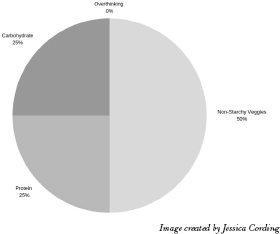
THE OVERTHINK-PROOFPLATE

PORTION SIZES CAN be daunting. We hear all this stuff about cups and grams and tablespoons and macronutrients, and it’s enough to make your head spin. To help simplify your life and give you flexibility in any dining situation, follow this overthink-proof formula for at least two meals per day:
THE OVERTHINK-PROOF PLATE

Fill half your plate with non-starchy veggies. In that category, you’ve got stuff like:
• leafy greens
• asparagus
• cruciferous vegetables, including broccoli, cauliflower, and brussels sprouts
• cucumber
• eggplant
• peppers
• zucchini and summer squash
Fill a quarter of your plate with protein, which could be animal or plant protein. A few examples:
• meat
• poultry
• fish
• eggs
• dairy
• beans, lentils
• nuts, seeds, or nut or seed butter
• tofu, tempeh, or other soy product
• seitan (made from vital wheat gluten)
Fill the last quarter of your plate with carbohydrates, which could include:
• Grains
• Starchy vegetables like potato, sweet potato, winter squash, corn, or peas
• Beans or lentils (if they’re not serving as your protein source)
• Fruit
Here are a few examples of what a full meal might look like, whether you’re using a plate, bowl, or glass:
• Two eggs with a half cup of roasted sweet potato and 1 cup of sautéed greens
• A piece of cooked meat, fish, or tofu with 1 cup of broccoli and a half cup of brown rice or quinoa
• A green smoothie made with plain Greek yogurt, half a frozen banana, half a cup of frozen berries, and 2 cups of baby spinach
If you’re wondering where fat fits in, I’m glad you asked. As a rule of thumb, aim to have a source of fat at each of your meals, whether that’s in cooking oil, a garnish of nuts or cheese, or avocado or a spread like guacamole or hummus.
Also, if you’re someone who prefers to eat a sweet breakfast or are wondering what to do about snacks, aim to have a balance of protein, fat, and carbs and just make sure you cover your bases with vegetables later in the day.